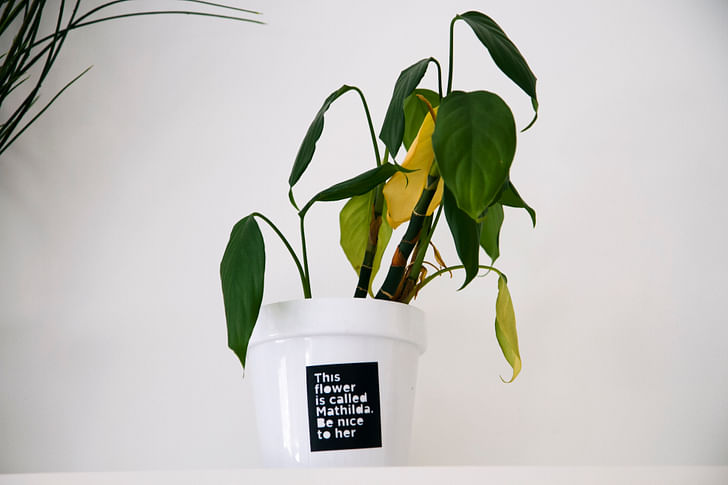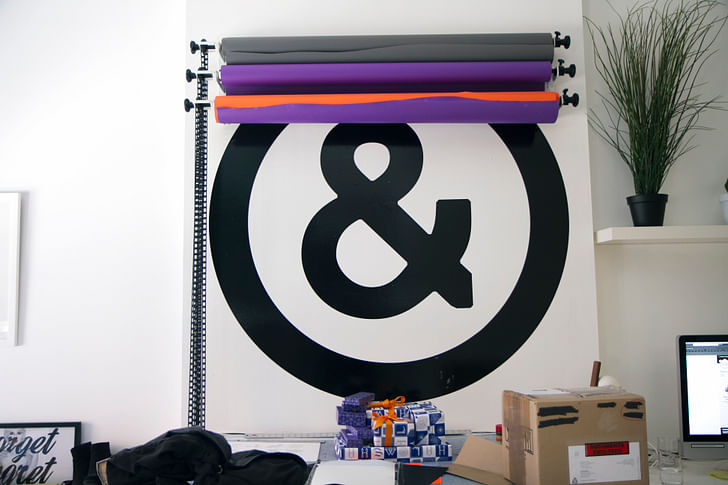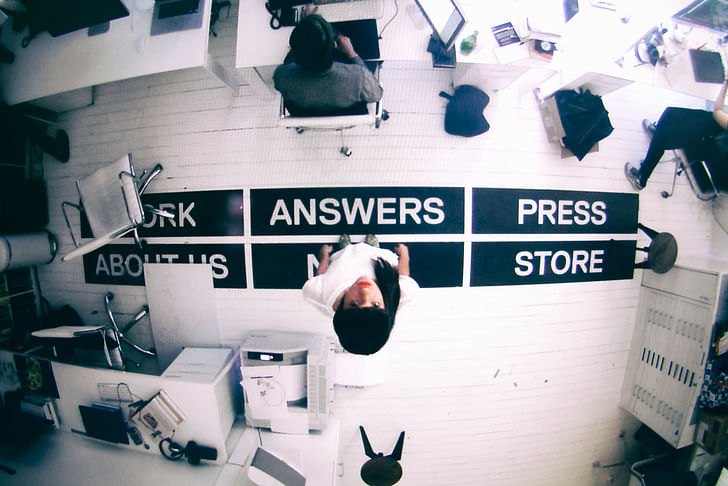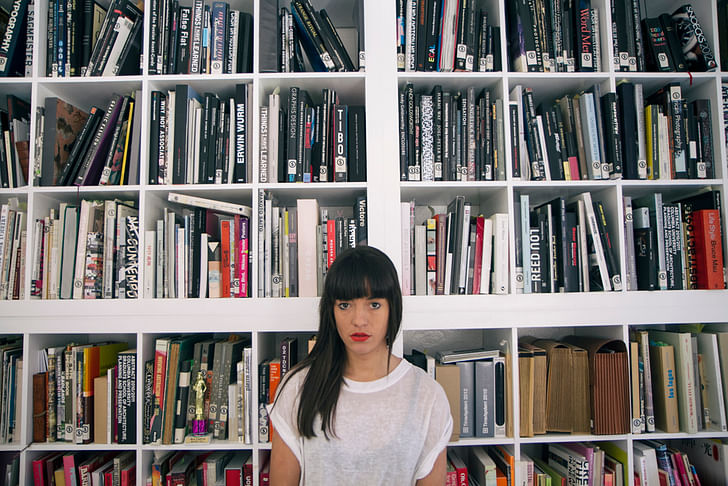

Intern Magazine is devoted to “intern culture” in the creative industries, elevating the talents of an oft under-valued workforce in a classy, bi-annual glossy. Part polemic and part showcase, the magazine is dissatisfied upfront with the current state of unpaid/underpaid intern labor, and hopes its pages can provoke a reevaluation of the too-often exploited population.
The magazine began with a drastically successful Kickstarter in 2013, on the principle that success breeds from exposure, but too often, the cycle of unpaid work is taken for granted and left undiscussed. Intern culture is often resting on a double-edged sword: the rewards of access and exposure are great, so long as you can withstand the financial strain of working for little or no money. While not explicitly focused on architecture, the magazine is a boon to the plight of interns everywhere, as a space for advice, inspiration and community.
We’re featuring Intern’s second issue, its most recent from this past July. While still in its early phases of development, the magazine makes a concerted effort to sample from the other side of the community – those whose intern experience has led to a successful career – to share their experience and advice. To this end, our Screen/Print features Intern’s interview with Jessica Walsh, currently half of design firm Sagmeister & Walsh, former intern for Apple and Pentagram.

"Casting Jessica Walsh"
by Anne Quito
Jessica Walsh knows her way around a camera. After all, her daily work-life is broadcast on the internet via her studio’s overhead live webcam. Watching photographer Monica Lek take her portrait for this article was riveting. Take one: She strikes that beautiful signature deadpan expression looking straight on, perfect glossy bangs, vivid red-orange lips standing in front of a cloud of design books. She looks commanding in front of that massive shelf, despite her petite frame. Take two: Grinning same – composition – her wide smile foiling the rigid symmetry for a moment. Then, Monica gets the idea to get two guys from the studio to pick her up like a surfboard. “Let’s get some interns involved”. It throws her for a bit, giggles at the idea, but is game. “I’m just trying not to touch your boob”, says the designer lifting her by the arms. After a few rather delightfully awkward snaps, she regains composure and suggests some shots on the deck outside.
The multi-talented designer casts as the perfect Hollywood ingénue – confident but vulnerable, fabulous but fumbling, secretly shy. At 27, she is a partner at one of the world’s most sought after design firms, Sagmeister & Walsh. Her career trajectory too reads like a montage of breezy transitions and dissolves. She was making websites at age 12, graduated with honours at the Rhode Island School of Design (RISD) and interned at Apple and Pentagram where she worked for renowned graphic designer and artist Paula Scher. Segue to an associate art director post at Print magazine, transition to working with Stefan Sagmeister, winning an armful of industry awards along the way. Then cut to her viral blockbuster project, 40 Days of Dating (soon to be a feature film produced by Warner Brothers).
You chose an internship over a job at Apple after graduating. How did you come to that decision?
During my junior year at RISD, I interned for Apple and was offered a job right after. I couldn’t take it because I had another year to go in school, and they said to get in touch when I was about to graduate. During my senior year, I thought to myself, if there were anywhere else I'd People often say that your portfolio should be well rounded and should have something that shows your versatility. But, I realised that is a crapshootrather work than Apple, where would it be? I felt that my heart was so much at Pentagram and was drawn to working in a studio environment. I also respected Paula Scher so much. I thought I had a lot to learn from working there, so I took an internship instead of going back to Apple when I graduated.
I can be indecisive about menial stuff – like I can never pick a restaurant to go to, or I can never to choose what to do after work – but when it comes to my career and my work I'm very decisive. I’ve always had these really strong feelings that have developed as I grow older – like an internal compass. Starting from when I was around 11 or 12 years old, I realised that when I followed my gut it usually works out. Even if it doesn't work out at first, somehow down the road it was the right thing to do. I think it's the feeling that drives everything I do, even in my design work.

What do you think interns bring to your own practice?
Our interns bring a fresh perspective as well as personality. Because we're so small, the dynamic is always changing. We have interns here for three months at a time. Our last intern was amazing at 3D processing. All of a sudden, we started thinking about our projects and how can we do more of this interactive type work. They're always bringing a fresh voice, style and energy to the studio – that and definitely good music recommendations.
How are your interns compensated?
Ours are unpaid. We pay for their lunches. I think it's on a situational basis whether people are comfortable with that, and can handle that. But I think internships in general are just a fantastic opportunity for people to learn and get close to people they really admire and respect. It’s a chance for them to learn from them and possibly grow. Most of our designers started as interns and then we ended up hiring them.


Sagmeister & Walsh has a notorious three-year waitlist for internships. How does one stand out?
It's really the work that I look at. We often prefer applications sent via email, however, sometimes when it's really thoughtfully done and they customise it for us, a printed piece is welcome. It shouldn't be some complicated kit or website where you have to spend ten minutes to figure out how to navigate – big, beautiful easy presentation. If they stand out in some way, sometimes that's from the work, sometimes it’s something else. We had one guy climb a huge stepladder and paint a picture on our window. Then one time, someone sent us a full-size cardboard naked cut-out of himself.
Did the naked cardboard picture guy get the job?
No. He did not. But when it's sweet, thoughtful and clear that they're so passionate, that's when it usually works out with our interns. They have to really, really want to be doing it.
I look for someone that I'm going to get along with, because half of it is about how good the work is and half of it is whether there is a nice connection between me and that person. Because I don't want to fill my studio with people that are assholes. They have to be nice people, and we have to get along. Of course, I can't say that it's going to work for their next interview, because the next interviewer is a totally different person and they might respond to a different type of personality, but for me, I just look for nice people that are really passionate about what they're doing.

Speaking of attention-grabbing methods, how did you present yourself as a student applying for jobs?
I think I was just very honest with my portfolio and with myself. I didn't try to sell myself. I was like, this is who I am and this is my work. People often say that your portfolio should be well rounded and should have something that shows your versatility. But, I realised that is a crapshoot, some people will like that, some people won't. You might as well put the things that you feel is your best work and shows what you want to be doing. You often get hired based on that.
Do you believe in personal branding?
That’s kind of weird. You know, this whole ‘branding yourself’ idea. I think there's definitely an importance to social media and having a presence, but giving yourself a logo is odd. I think it's completely unnecessary.

When you launched Sagmeister & Walsh, there was that infamous full frontal naked photo of you next to Stefan. How did that come about?
I felt in that case it made a lot of sense, because when Stefan started the studio he had done the naked portrait, so it made sense to remake it. It was a joke about a joke, and I wouldn't get naked for any type of shoot. It's completely on a case-by-case basis, and it's that gut instinct thing, if I feel like it's right or not.
You seem to be comfortable revealing your persona online, especially in the 40 Days of Dating project. How do you determine what you disclose about your personal life and what to keep private?
Since I got my start on the web, I spent a lot of time on young teen forums where I'd connect with other kids. I wasn't really popular in school and I really found a connection by meeting people online. I was very private and introverted, but I found that that worked for me and I could be more open through a computer, for some reason, which is kind of interesting.
People don't want to see this perfectly painted picture. They like to hear that you're human – that you eat brunch … that you fartThen I went back to being more private, up until the last few years here, and more and more I realised that the more open and honest and human you are, the more people seem to respond to that. When I first was starting I wouldn't tweet about anything personal. I kept everything very, very professional. I didn't talk about my personal life.
But I'm realising that the more you reveal who you are, the more people respond. People don't want to see this perfectly painted picture. They like to hear that you're human – that you eat brunch … that you fart … We all do these things.

Do you find that your virtual life and your real life are seamless right now?
I still curate, but less and less, and I think as my life goes on I probably will continue in that direction, as I get more comfortable.
You name your business partner, Stefan as your most formative mentor. What are some lessons you’ve learned from him so far?
I think one of the biggest things I've learned from him is how important it is to understand business and how to sell your work. He’d often say in interviews how he learned from Tibor Kalman that the best design studios aren't necessarily the best designers. It's the ones with an amazing sales person that can get the work through. You can do great work all day long, but if you can't sell it to the client it's never going to see the light of day. From my first day here, watching Stefan interact with clients has been fascinating.
I’ve also learned a particular approach to running a business from Stefan. I think my instinct would have been to just keep growing the company. We would get great job offers, and I would suggest bringing in more designers. Let's do this, I thought. But he is really adamant about keeping it very small and just saying no. So, we would accept the work based on the amount of people we had. That approach was kind of shocking to me at first but now I really see the benefits of that.

If you could intern for anyone – living or dead – who would it be?
I’m fascinated by the stuff I’ve read about Freud. I’m curious to learn where it all comes from. I’d love to have a conversation. Three months with Sigmund Freud, yes.
Jessica Walsh teaches at the School of Visual Arts in New York City and is engaged to Zak Mulligan, a cinematographer.

Go here for a complete list of contributors to Intern Magazine, issue #2.
Screen/Print is an experiment in translation across media, featuring a close-up digital look at printed architectural writing. Divorcing content from the physical page, the series lends a new perspective to nuanced architectural thought.
For this issue, we featured Intern Magazine.
Do you run an architectural publication? If you’d like to submit a piece of writing to Screen/Print, please send us a message.
Former Managing Editor and Podcast Co-Producer for Archinect. I write, go to the movies, walk around and listen to the radio. My interests revolve around cognitive urban theory, psycholinguistics and food.Currently freelancing. Be in touch through longhyphen@gmail.com
Are you sure you want to block this user and hide all related comments throughout the site?
7 Comments
Strange choice to interview the most hated designer in the world for Intern magazine.
She almost brags about not paying interns.
Reads like PR I've already read.
Her work is annoying, sort of an inauthentic fetish for Sagmesiters shock tactics slapped on a fashion catalog.
For reference
http://www.slate.com/articles/technology/technology/2014/01/do_what_you_love_love_what_you_do_an_omnipresent_mantra_that_s_bad_for_work.html
Love for work is no different than love in any other context. It takes persistence and a resolute determination to make it work. So you better make sure your work loves you back before you fall for it.
Anyway, good post - thanks for putting this up here, Amelia. Reading this reinforces the idea that unlicensed architects probably need a different title than "intern" in order to clarify their real role.
How does an unpaid intern live in New York City?
That slate article was a great read, and sums up why I never took an unpaid internship regardless the social cachet it may have given me. This Jessica Walsh story seems, to me, diametric to the message Intern Magazine should be publishing. It may be a high concept publication, but they should be choosing those to celebrate more carefully. Congrats to Jessica though, she lucked out...
Damn she's fine.
"The multi-talented designer casts as the perfect Hollywood ingénue – confident but vulnerable, fabulous but fumbling, secretly shy."
"Ours are unpaid. We pay for their lunches. I think it's on a situational basis whether people are comfortable with that, and can handle that. But I think internships in general are just a fantastic opportunity for people to learn and get close to people they really admire and respect."
Wow, this is some pretentious bootlicking drivel. Independently wealthy girl kickstarts career through unpaid internships, and then exploits young people to support her practice. Really, the Horatio Alger of our time.
Someone file an FLSA suit against this woman.
You can do better, Archinect.
Archinect
This is your first comment on Archinect. Your comment will be visible once approved.